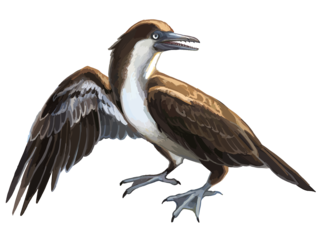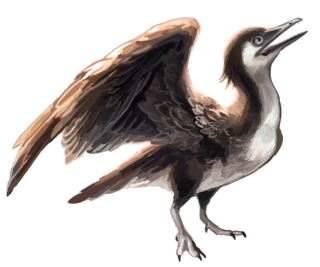
The Enantiornithes, also known as enantiornithines or enantiornitheans in literature, are a group of extinct avialans, the most abundant and diverse group known from the Mesozoic era. Almost all retained teeth and clawed fingers on each wing, but otherwise looked much like modern birds externally. Over eighty species of Enantiornithes have been named, but some names represent only single bones, so it is likely that not all are valid. The Enantiornithes became extinct at the Cretaceous–Paleogene boundary, along with Hesperornithes and all other non-avian dinosaurs.

Yanornis is an extinct genus of fish-eating Early Cretaceous birds. Two species have been described, both from Liaoning province, China: Yanornis martini, based on several fossils found in the 120-million-year-old Jiufotang Formation at Chaoyang, and Yanornis guozhangi, from the 124-million-year-old Yixian Formation.

Gansus is a genus of aquatic birds that lived during the Aptian age of the Early Cretaceous (Aptian-Albian) period in what are now Gansu and Liaoning provinces, western China. The rock layers from which their fossils have been recovered are dated to 120 million years ago. It was first described in 1984 on the basis of an isolated left leg. It is the oldest-known member of the Ornithurae, the group which includes modern birds (Neornithes) and extinct related groups, such as Ichthyornis and Hesperornithes.

Longipteryx is a genus of prehistoric bird which lived during the Early Cretaceous. It contains a single species, Longipteryx chaoyangensis. Its remains have been recovered from the Jiufotang Formation at Chaoyang in Liaoning Province, China. Apart from the holotype IVPP V 12325 - a fine and nearly complete skeleton — another entire skeleton and some isolated bones are known to date.

Confuciusornithidae is an extinct family of pygostylian avialans known from the Early Cretaceous, found in northern China. They are commonly placed as a sister group to Ornithothoraces, a group that contains all extant birds along with their closest extinct relatives. Confuciusornithidae contains four genera, possessing both shafted and non-shafted (downy) feathers. They are also noted for their distinctive pair of ribbon-like tail feathers of disputed function.
Songlingornis is an extinct genus of ornithuromorph dinosaurs from the Early Cretaceous. Its fossils have been found in the Jiufotang Formation of Liaoning (PRC). The age of these rocks is somewhat disputed, but probably around the early Aptian, 125-120 million years ago. Only one species, Songlingornis linghensis, is known at present.
Paleontology or palaeontology is the study of prehistoric life forms on Earth through the examination of plant and animal fossils. This includes the study of body fossils, tracks (ichnites), burrows, cast-off parts, fossilised feces (coprolites), palynomorphs and chemical residues. Because humans have encountered fossils for millennia, paleontology has a long history both before and after becoming formalized as a science. This article records significant discoveries and events related to paleontology that occurred or were published in the year 2002.

Pygostylia is a group of avialans which includes the Confuciusornithidae and all of the more advanced species, the Ornithothoraces.
The Jiufotang Formation is an Early Cretaceous geological formation in Chaoyang, Liaoning which has yielded fossils of feathered dinosaurs, primitive birds, pterosaurs, and other organisms. It is a member of the Jehol group. The exact age of the Jiufotang has been debated for years, with estimates ranging from the Late Jurassic to the Early Cretaceous. New uranium-lead dates reveal the formation is deposited in the Aptian stage of the Early Cretaceous. Fossils of Microraptor and Jeholornis are from the Jiufotang.
Chaoyangia is an extinct genus of euornithean birds, containing the single species Chaoyangia beishanensis. This species is known from a single fossil specimen consisting of a partial skeleton including vertebra, ribs, hips, and upper legs. The specimen was discovered in the Jiufotang Formation near the city of Chaoyang in Liaoning province, China. This rock formation has been dated to the Aptian age of the Early Cretaceous period, 120 million years ago.

Shanweiniao is a genus of long-snouted enantiornithean birds from Early Cretaceous China. One species is known, Shanweiniao cooperorum. There is one known fossil, a slab and counterslab. The fossil is in the collection of the Dalian Natural History Museum, and has accession number DNHM D1878/1 and DNHM1878/2. It was collected from the Lower Cretaceous Dawangzhengzi Beds, middle Yixian Formation, from Lingyuan in the Liaoning Province, China.
Zhongjianornis is a genus of beaked, pigeon-sized birds from the early Cretaceous period of China. It is known from one fossil found at Jianchang, Liaoning Province, in rocks of the Jiufotang Formation, representing the type species Zhongjianornis yangi.

The Yixian Formation is a geological formation in Jinzhou, Liaoning, People's Republic of China, that spans about 1.6 million years during the early Cretaceous period. It is known for its fossils, listed below.
Hongshanornithidae is an extinct group of early ornithuromorph birds from the early Cretaceous period of China. It includes the genera Hongshanornis and Tianyuornis from the Yixian Formation of Inner Mongolia, Longicrusavis from the Yixian Formation of Liaoning Province, Parahongshanornis from the Jiufotang Formation of Liaoning Province, and Archaeornithura, the oldest known member, from the Huajiying Formation of Hebei Province.

Yanornithiformes is an order of ornithuromorph dinosaurs from the early Cretaceous Period of China. All known specimens come from the Yixian Formation and Jiufotang Formation, dating to the early Aptian age, 124.6 to 120 million years ago.

Longipterygidae is a family of early enantiornithean avialans from the Early Cretaceous epoch of China. All known specimens come from the Jiufotang Formation and Yixian Formation, dating to the early Aptian age, 125-120 million years ago.
Dingavis is an extinct genus of ornithuromorph dinosaurs from the Early Cretaceous of present-day China. It contains a single species, D. longimaxilla.
Abitusavis is an extinct genus of ornithuromorph dinosaurs from the Early Cretaceous Yixian Formation of China. The genus contains a single species, Abitusavis lii, known from a nearly complete skeleton.
Similiyanornis is an extinct genus of ornithuromorph dinosaurs from the Early Cretaceous Jiufotang Formation of China. The genus contains a single species, Similiyanornis brevipectus, known from a complete skeleton with feathers.




















